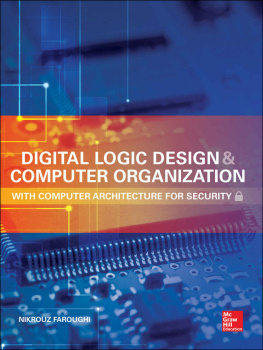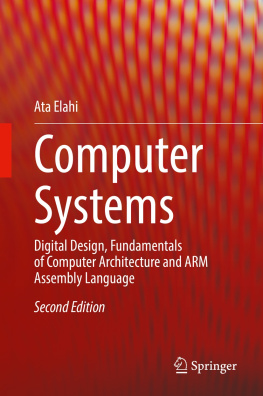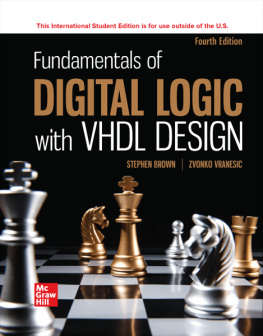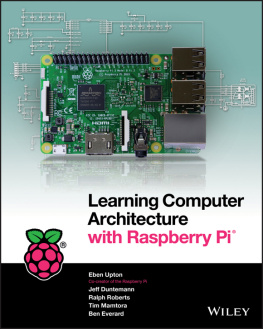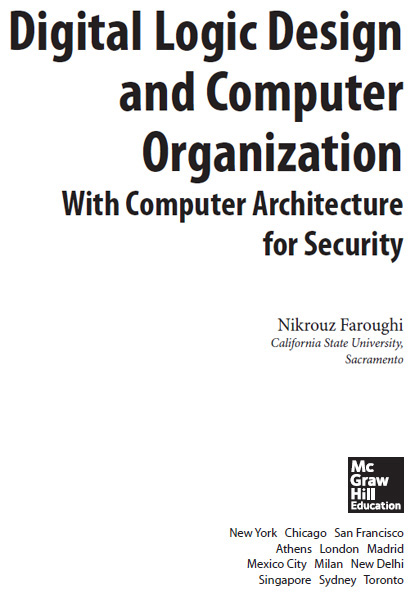About the Author
Nikrouz Faroughi has a BS in computer engineering, MS in computer science, MS in electrical engineering, and PhD in electrical engineering with a specialization in computer engineering from Michigan State University. He has worked as a systems analyst and currently is a professor and graduate coordinator in the Computer Science Department and a faculty member in the Computer Engineering Program at California State University, Sacramento. As a consultant, he has worked and also served as a technical manager at Intel Corporation.
Copyright 2015 by McGraw-Hill Education. All rights reserved. Except as permitted under the United States Copyright Act of 1976, no part of this publication may be reproduced or distributed in any form or by any means, or stored in a database or retrieval system, without the prior written permission of the publisher.
ISBN: 978-0-07-183808-5
MHID: 0-07-183808-2
The material in this eBook also appears in the print version of this title: ISBN: 978-0-07-183690-6, MHID: 0-07-183690-X.
eBook conversion by codeMantra
Version 1.0
All trademarks are trademarks of their respective owners. Rather than put a trademark symbol after every occurrence of a trademarked name, we use names in an editorial fashion only, and to the benefit of the trademark owner, with no intention of infringement of the trademark. Where such designations appear in this book, they have been printed with initial caps.
McGraw-Hill Education eBooks are available at special quantity discounts to use as premiums and sales promotions or for use in corporate training programs. To contact a representative, please visit the Contact Us page at www.mhprofessional.com.
Information contained in this work has been obtained by McGraw-Hill Education from sources believed to be reliable. However, neither McGraw-Hill Education nor its authors guarantee the accuracy or completeness of any information published herein, and neither McGraw-Hill Education nor its authors shall be responsible for any errors, omissions, or damages arising out of use of this information. This work is published with the understanding that McGraw-Hill Education and its authors are supplying information but are not attempting to render engineering or other professional services. If such services are required, the assistance of an appropriate professional should be sought.
TERMS OF USE
This is a copyrighted work and McGraw-Hill Education and its licensors reserve all rights in and to the work. Use of this work is subject to these terms. Except as permitted under the Copyright Act of 1976 and the right to store and retrieve one copy of the work, you may not decompile, disassemble, reverse engineer, reproduce, modify, create derivative works based upon, transmit, distribute, disseminate, sell, publish or sublicense the work or any part of it without McGraw-Hill Educations prior consent. You may use the work for your own noncommercial and personal use; any other use of the work is strictly prohibited. Your right to use the work may be terminated if you fail to comply with these terms.
THE WORK IS PROVIDED AS IS. MCGRAW-HILL EDUCATION AND ITS LICENSORS MAKE NO GUARANTEES OR WARRANTIES AS TO THE ACCURACY, ADEQUACY OR COMPLETENESS OF OR RESULTS TO BE OBTAINED FROM USING THE WORK, INCLUDING ANY INFORMATION THAT CAN BE ACCESSED THROUGH THE WORK VIA HYPERLINK OR OTHERWISE, AND EXPRESSLY DISCLAIM ANY WARRANTY, EXPRESS OR IMPLIED, INCLUDING BUT NOT LIMITED TO IMPLIED WARRANTIES OF MERCHANTABILITY OR FITNESS FOR A PARTICULAR PURPOSE. McGraw-Hill Education and its licensors do not warrant or guarantee that the functions contained in the work will meet your requirements or that its operation will be uninterrupted or error free. Neither McGraw-Hill Education nor its licensors shall be liable to you or anyone else for any inaccuracy, error or omission, regardless of cause, in the work or for any damages resulting therefrom. McGraw-Hill Education has no responsibility for the content of any information accessed through the work. Under no circumstances shall McGraw-Hill Education and/or its licensors be liable for any indirect, incidental, special, punitive, consequential or similar damages that result from the use of or inability to use the work, even if any of them has been advised of the possibility of such damages. This limitation of liability shall apply to any claim or cause whatsoever whether such claim or cause arises in contract, tort or otherwise.
Contents
Preface
T his book is designed with the goal of providing a comprehensive understanding of digital logic design and computer organization in a single textbook. In addition, the book contains an entire chapter on computer architecture for security.
The book covers both the fundamentals of digital logic design and design with the Verilog hardware description language. Separate chapters are allocated to cover design methodologies of simple and complex combinational and sequential circuits. Modern tools and methodology for circuit design are discussed in general, and Verilog examples illustrate only the basic and synthesizable features of the language. If desired, instructors may choose to use VHDL instead. However, the book does not require using a hardware description language.
The book covers memory organization, processing core and processor organization, and computer security through hardware. As advancements in technologies and demand for high-speed and low-power designs have changed the fundamentals of computer organization, an attempt is made to provide not only simple examples to illustrate basic design concepts, but also provide an understanding of modern computer design objectives.
The book also covers computer architecture concepts from instruction set architecture, including the architecture for secure execution, pipelining and parallelism, and memory hierarchy. An attempt is made to provide numerous examples that illustrate the applications of pipelining and parallelism to increase concurrency and reduce or hide latency (two factors that affect performance). Program code examples are also used to illustrate the link between CPU architecture and a compiler and between programing methodologies and performance.
Overview of Chapters
There are 11 chapters in this book. An overview of digital systems, innovations in computing, number systems, digital logic design, and computer organization/architecture and security is given in .
covers methodologies used to design large combinational circuits and introduces integer and floating-point computer arithmetic and also presents design examples.
covers single-cycle, multicycle, and pipelined data paths and controls. Design examples illustrate data path and FSM-based, microprogrammed, and pipelined control unit organizations. Several data path design examples, including for unsigned and signed multiplication and two-dimensional virtual object rotation, are also presented.
is dedicated to memory and covers memory technologies, including SDRAM technologies, and memory design, including interleaving and multichannel. Memory communication protocols, performance, and uniform memory access (UMA) and nonuniform memory access (NUMA) organizations are also presented. Examples of programing methodologies to take advantage of a NUMA organization to improve performance are also discussed.
covers CPU design, from single-cycle and pipeline, to reduced instruction set computer (RISC), deep pipelining, and branch prediction, to static and dynamic instruction-level parallelism (ILP), to multithreading. The chapter includes design and simulation of CPU data path examples and presents program code examples to illustrate compiler optimization to improve performance, branch prediction, ILP, and multithreading.

